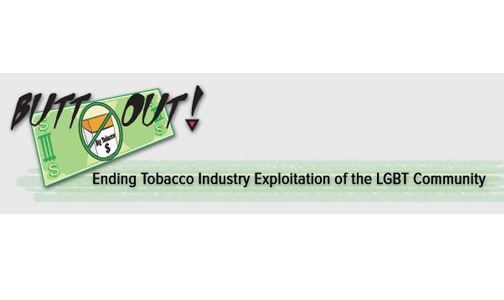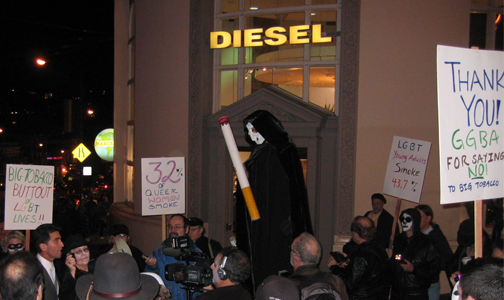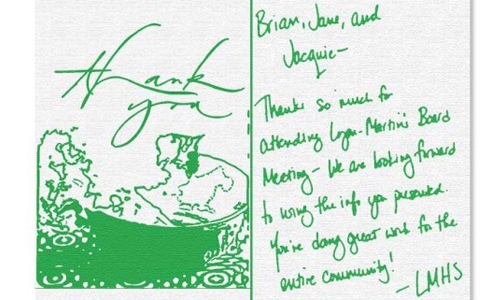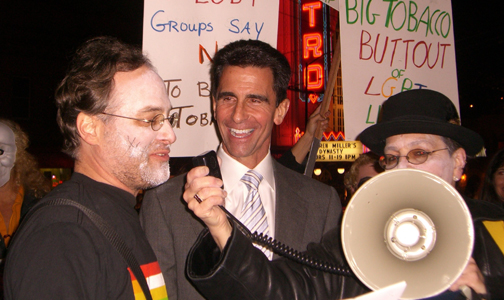- Introduction: What is Butt Out?BUTT OUT! is a project of Breathe California, which is funded by the San Francisco Tobacco Free Project, San Francisco Department of Public Health. The project works with lesbian, gay, bisexual, and transgender-serving (LGBT) organizations to fight tobacco industry exploitation of the LGBT community.BUTT OUT! works to raise awareness that smoking is a primary health concern in the LGBT community, and partners with LGBT organizations to reject tobacco industry sponsorship and funding.
- THE PROBLEM: Tobacco Industry targeting of LGBT CommunityThe tobacco industry began to target the LGBT community in 1992, when the first cigarette ad appeared in a gay men’s publication. About that time, R.J. Reynolds launched Project SCUM – Subculture Urban Marketing – as a way to increase smoking rates among gays and the homeless in San Francisco. Since then, the tobacco industry has become a major contributor to LGBT and HIV/AIDS organizations, events, and publications. Phillip Morris (aka Altria) alone has donated more than $14 million to HIV/AIDS efforts since 1986. By 1999, tobacco was among the top ad categories in LGBT newspapers and magazines. Among the ads specifically designed for the LGBT community is one that equates the “freedom to marry” with the “freedom to inhale.”
Industry tactics have been quite successful. Smoking in the LGBT community is twice that of the general population.
- Gay and bisexual men smoke about 50% more than all men in California;
- Lesbian and bisexual women smoke about three times as much as all women;
- Transgender people smoke twice as much as all people; and
- LGBT young adults 18-24 years old smoke 43.7% – about two and a half times as much as all young adults in California.
What the advocates were trying to accomplish
The goal of this project was to heighten awareness within the LGBT community about the impact that tobacco industry targeting has on all LGBT individuals and to limit tobacco industry sponsorship of LGBT events.
- THE INTERVENTION MODEL: Butt Out! utilized the Community Action Model (CAM), a process that builds on the strengths or capacity of a community to create change from within and mobilizes community members and agencies to change environmental factors promoting economic and environmental inequalities.
The Community Action Model includes the following steps:
- Train Participants: Community Action Team (CAT) members are recruited and trained to develop skills, increase knowledge and build capacity. The participants will use this knowledge and skills to choose a specific issue or focus and then design and implement an action to address it.
- Do a Community Diagnosis: A community diagnosis is the process of finding the root causes of a community concern or issue and discovering the resources to overcome it.
- Choose an Action: to address the issue of concern. The Action should be: 1) achievable, 2) have the potential for sustainability, and 3) compel a group/agency/organization to change the place they live for the well being of all.
- Develop and Implement an Action Plan: The CAT develops and implements an action plan to achieve their Action which may include an outreach plan, a media advocacy plan, development of a model policy, advocating for a policy, making presentations as well as an evaluation component.
- Enforce and Maintain the Action: After successfully completing the action, the CAT ensures that their efforts will be maintained over the long term and enforced by the appropriate bodies.
- THE STRATEGIES: How Butt Out adapted the Community Action ModelWith a 3-year grant from the San Francisco Tobacco Free Project, Butt Out! implemented a process that would result in at least two LGBT-serving organizations or institutions agreeing to sign pledges or adopt policies not to accept sponsorship from tobacco companies.
1. Train Participants
BUTT OUT recruited eleven adult advocates. Advocates from BUTT OUT, along with advocates from other Tobacco Free Project funded projects participated in a 4 hour joint training on July 16 2008. The training covered a variety of topics including tobacco as a social justice issue, the global reach of tobacco, the impact of the tobacco industry on communities of color, and how to effectively implement the Community Action Model (CAM).
2. Do a Community Diagnosis
Butt Out! advocates undertook a multi-part community diagnosis during the Fall of 2008 in the form of surveys, research, and interviews.
Survey. The advocates designed a survey tool to measure community opinion on the issue of tobacco usage in the LGBT community and tobacco company sponsorship of LGBT organizations. A pilot survey was administered to 113 people during the Pride Kickoff event in early June 2008 at the San Francisco LGBT Center. The survey was modified, based on results from the pilot, and the modified survey was then administered to 869 individuals during San Francisco Pride in late June 2008.
Survey results showed that the vast majority of respondents were: 1) aware that smoking is a major problem in the LGBT community; 2) understood the connection between promotion of tobacco and tobacco addition; 3) understood that tobacco companies donate to LGBT organizations to promote their products, not to help the community; and 4) agreed that LGBT organizations should not be accepting tobacco funding.
Research and interviews. The advocates identified individual and community strengths and assets through the Midwest Academy Strategy Chart to determine potential supporters and allies as well as opponents. A list was compiled of key leaders, city departments, community groups, and other stakeholders such as LGBT organizations, businesses, and elected officials that had previously adopted similar policies. The advocates interviewed several representatives about why their organization had adopted a policy refusing tobacco company sponsorship, and the lessons they learned during the process of adopting the policy and in the aftermath. The advocates also began to acquire statements of support from previous policy adoptees.
In addition, Butt Out! advocates interviewed a number of projects throughout California that were working on tobacco sponsorship issues to collect data, talking points, and model policies, along with legal rationales organizations could use to refuse to sign a policy, and also learn about successful strategies. Suggestions from interviewees included:
- Develop an education packet;
- Tailor policies to the organization;
- Be ready to explain what the organization has to gain from the policy adoption – other than knowing it had done the right thing for the community’s health;
- Provide significant publicity (e.g., press releases) to groups that adopt a policy – since tobacco is not an area of great concern to many LGBT groups, positive public visibility can help to motivate other groups that may be resistant;
- Be prepared to respond realistically to concerns groups have about whether adopting a tobacco-free sponsorship policy will translate into other types of donations.
- Identify an individual inside the organization who is strongly motivated to make change happen.
- Use the gay press to promote each group that adopts a policy and, conversely, to target those that refuse to adopt policies.
The advocates researched the literature about how sponsorship hurts the LGBT community and used that information in campaign materials, letters, and model sponsorship policy findings. A UCSF School of Nursing study was entitled, “Is tobacco a gay issue?” was also reviewed That study revealed that the majority of LGBT leaders of non-profits and businesses nationally do not consider tobacco to be a major issue in the community and saw no problem accepting funding or advertising from tobacco companies. The advocates used this article to create a list of potential attitudes that they might encounter in their outreach to organizations and prepared responses to those attitudes.
3. Choose an Action
The action chosen by Butt Out! to raise awareness within the LGBT community about the impact of tobacco industry targeting was to advocate, through outreach, education, community organizing, and media advocacy, for at least two LGBT-serving groups or institutions to sign pledges or adopt policies not to accept sponsorship money from tobacco companies
4. Develop and Implement an Action PlanThe advocates selected six groups they planned to target as potential policy adoptees and collected information about each, including:
- The population that was served;
- Tobacco funding history;
- Existing policies that restrict funding sources;
- Who has authority to pass policies;
- Organizational gatekeeper(s);
- The organization’s process for adopting policies;
- Stakeholders; and
- List of donors/sponsors and their sponsorship policies, if appropriate.
Butt Out! used survey data and findings from interviews and its other research to develop an educational packet, PowerPoint presentation, and talking points to use in conversation and correspondence with potential policy adoptees.
The advocates focused on finding connections to individuals within the various organizations that they normally reach out to and partner with to help get connected to targeted organizations and groups as potential policy adoptees. The advocates conducted basic outreach, sent out education packets, and followed up with phone calls and emails.
Butt Out! engaged in a number of activities to educate the LGBT population and activate them on the issue of tobacco sponsorship, including:
- Sponsoring the San Francisco LGBT film festival,
- Developing a separate educational piece for LGBT youth because of high rates of smoking in that population, and
- Staffing booths at health and educational fairs and during the San Francisco Pride event.
The advocates’ overall strategy included:
- Conducting outreach to key decision makers and key personal contacts within or connected to various organizations at appropriate times;
- Using the Education Packet as an effective tool to engage potential adoptees;
- Using the model policy and examples of policies already adopted to help organizations understand specifically what they were being asked to do and showing them that others have adopted policies;
- Creating and conducting new targeted presentations as needed;
- Using the Butt Out! booth at Pride and other outreach opportunities at Frameline, the GSA Network youth presentation, and other events to educate the community on the broader issues and to create awareness of the value of tobacco free policy adoption; and
- Using the media to promote organizational leaders that had adopted policies and to encourage others to join the campaign. Major organizations that adopted policies were given special media attention. The media was also used to celebrate all of the adoptees at the end of the year.
Results of the Action Plan
Butt Out! was successful in obtaining commitments from 10 LGBT-serving organizations to adopt tobacco free funding policies. This far exceeded its goal to achieve two LGBT organizations to sign or adopt policies not to accept sponsorship money from tobacco companies.5. Enforce and Maintain the Action
Of the 10 groups that committed to adopt tobacco-free funding policies, five signed written policies. Most of the other five groups are volunteer groups that may or may not have bylaws, although some signed a “decorative” policy.Signed written policies
- Lyon-Martin Health Services
- Dimensions Clinic
- Golden Gate Business Association
- Lavender Seniors of the East Bay
- National Center for Lesbian Rights
Volunteer groups
- Bayard Rustin LGBT Coalition
- Bay Area American Indian Two-Spirits
- Harvey Milk LGBT Democratic Club
- And Castro for All
- Marriage Equality USA
Another group, Openhouse has a record of the policy vote in their meeting minutes, although it was not willing to incorporate language into its bylaws.
Lastly, the 2009 Frameline San Francisco LGBT Film Festival featured several educational components, including brief public service announcements about LGBT smoking issues. Hundreds of festival-goers received handouts about the effect of smoking in movies on viewers. Through direct outreach, 17 Gay-Straight Alliance presidents were educated about how tobacco companies target LGBT youth and were given materials to educate their membership.
- CHALLENGES: A primary challenge for the project was building the base of the advocate team. One person was recruited from the previous team, which helped preserve some continuity. Of particular concern was achieving a gender balance (the previous team had been all male). Ads were run on Craigslist and on the project’s own website. A woman who had previously been a volunteer became involved with the project. She sent out information to a women’s list and was successful in recruiting another advocate. A transgender person who came to one of the educational fairs was also recruited to be an advocate.Since tobacco is not a priority for most of the organizations contacted, an ongoing challenge was getting groups to respond to phone calls and emails. Considerable outreach was conducted in the community, and the advocates strategically attended events where they knew it would be easier to speak directly to executive directors of the targeted organizations.
- LESSONS LEARNED: The best approach to getting connected to groups that were potential adoptees was to focus on organizations with existing connections to Butt Out! and on people with an interest in tobacco control.
Having a strong, committed internal advocate within the organization who helped to move the policy adoption process forward was a major factor in four of the first five groups that adopted policies.
The advocates found that using a “draw more flies with honey than vinegar” approach where policy adoptees were publicly honored and acknowledged was more appealing than antagonizing organizations that were well regarded in the community with negative publicity.On a professional level, the project coordinator learned to be a better volunteer/advocate manager by being less aggressive with volunteers than he had been on previous projects. As a result, he was able to build a team of more self-motivated advocates.
- Download: case study
Download the case study here.
Eliminating Local Tobacco Industry Funding (2010)
Butt Out
R.J. Reynolds launched Project SCUM—Subculture Urban Marketing—as a way to increase smoking rates among gays and the homeless in San Francisco.



